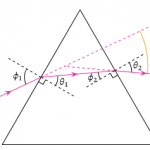Refraction refers to the change in direction of a wave, while diffraction is the spreading of waves. Moreover, they are important concepts in the field of physics with a variety of applications. In this article, you will learn about the concepts of refraction and diffraction, their differences, and review commonly asked questions about each phenomenon.
Refraction
Refraction is the redirection of a wave when it passes from one medium to another. Moreover, this change in direction is because of a change in the speed of the wave or the difference in the densities of the media. Although refraction of light waves is the most noticeable, other wave forms such as sound and water also experience it. When it comes to light waves, they are fastest in a vacuum and air. But when they enter a denser medium such as glass, speed reduces, and direction changes at the interface of the two media. The speed of the light wave in the first and second media (v1 and v2), as well as the refractive index of both media (n1 and n2), are related to the angles of incidence (θ1) and refraction (θ2) as follows:
![]()
In Physics, it is common to refer to this expression as Snell’s law or the law of refraction. Refraction is noticeable when waves move between media of different densities, unlike diffraction that can occur within the same medium.
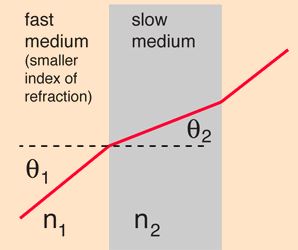
Examples of Refraction
As a phenomenon, there are several occurrences and useful applications of refraction.
Refraction in Eyeglasses
One of the common applications of refraction of light waves is in the use of eyeglasses. Typically, the human eye focuses incoming light on the correct spot of the retina to see an image. Due to some defects, the light may not be focused on the correct spot, leading to unclear vision. However, the use of glasses with the appropriate features help to bend the light to focus on the right spot for the formation of clear images.
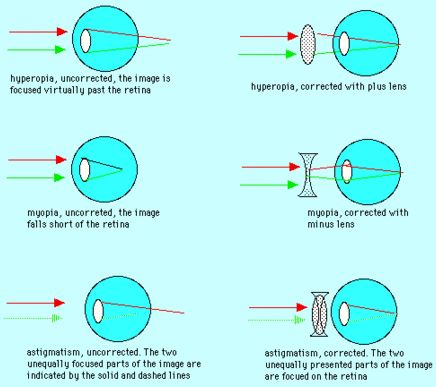
Underwater Acoustics
In deep water bodies such as oceans, the speed of sound in water varies with depth. As a result, sound waves propagate from one depth to another follow a curved path. Moreover, this curved path is inversely proportional to the sound speed gradient, which varies according to the season. Knowledge of this variation is pivotal to subsea communications for military and exploratory purposes, especially using the SOFAR channel.
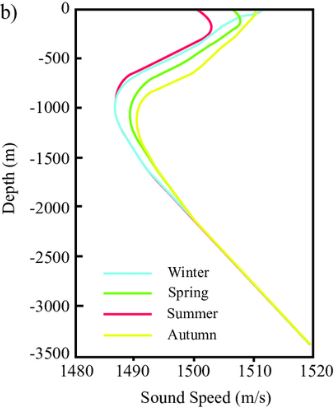
Atmospheric Refraction
Because air density varies as a function of height, electromagnetic waves from the sun deviate as they traverse through the atmosphere. As a result, the perceived position of the sun is different from the actual position as the figure below shows.
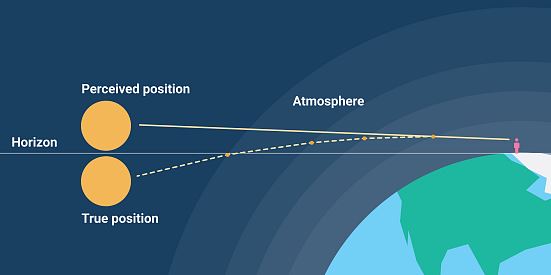
Diffraction
Diffraction is the spreading out of waves as they pass through an aperture, or the bending of waves as they pass around an obstacle. Usually, it occurs when the incident wavelength is of the same order of magnitude as the size of the aperture or obstacle. Unlike refraction, the trigger of diffraction is not a change in the density of a medium.
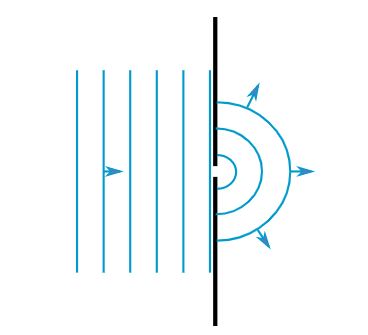
Examples of Diffraction
The following sections contain examples of common occurrences of wave diffraction.
X-ray Diffraction
X-ray is an electromagnetic wave that is important in identifying and characterizing the nature of crystalline material. When used on the human body, it finds minor defects in the bone or other parts because they diffract as they encounter these obstructions. Thus, it reveals the nature of everything on its path.
Diffraction of Light
There are a host of scenarios of light wave diffraction in nature, and useful applications of it. For example, a hologram, which is a 3D impression of an image, results from diffracting different versions of the image to a lens from multiple sides. Then, the combination of these versions is subsequently projected to the holographic plate to produce a 3-dimensional experience.
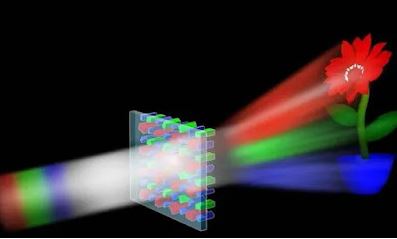
Another example of light wave diffraction is in the bending of light at the corners of a door. If a dark room is adjacent to another with the lights on, and the door is slightly open, some light will enter through the gap. This shows that the waves leave their straight path and bend around the corner of the door to enter the room.

Difference Between Refraction and Diffraction
Refraction and diffraction are similar wave properties because they both entail the bending of traveling waves. However, there are basic differences between refraction vs. diffraction as the table below outlines.
| Refraction | Diffraction |
| It occurs only at the interface when moving from one medium to another. Or it can occur within the same medium when there is a density change. | Diffraction is a result of encountering obstacles or apertures on the wave path. |
| The major contributor to the refraction of a wave is its change in speed. | Diffraction increases with increasing wavelength. |
| In refraction, there is only bending of the wave. | In diffraction, the wave disperses in addition to the bending. |
| Refraction can make objects appear in a different position than they are. | Diffraction does not result in optical illusions as with refraction. |
Commonly Asked Questions about Refraction vs Diffraction
Because refraction and diffraction are common occurrences in nature, there are numerous questions about them. This section addresses some of these questions.
What are the types of refraction vs diffraction?
The two types of diffraction are Fresnel diffraction and Fraunhofer diffraction. Fresnel diffraction occurs when the light source and the screen are at a finite distance from the obstacle causing the diffraction. As a result, the wave front is spherical after encountering the obstacle, hence producing a fringed image. Fraunhofer diffraction occurs when both the source and the screen are at infinite distance from the obstacle, thus, producing plane wave fronts.
When it comes to refraction, there are no types. Rather, there are types of refractive index. These types are absolute and relative refractive index. Absolute refractive index refers to the ratio of the speed of light in air to the speed of light in a material medium. Relative refractive index is the refractive index in one material medium with respect to another one.
Do refraction and diffraction slow down light?
When diffraction occurs, all the properties of the wave such as wavelength, frequency, period, and speed remain the same. Only the direction changes. However, during refraction, the speed of light either increases or decreases depending on the densities of the media and direction of propagation. If the light is moving from a less dense medium to a denser medium, it slows down. But, if heading in the opposite direction, it gains speed.
How do we use refraction and diffraction in our everyday life?
The application of diffraction vs refraction is common in everyday life. For example, diffraction gratings are essential in any spectrum analysis work such as forensic and chemical analysis, as well as astronomy. Also, it is important in the use of x-rays and holograms.
As for refraction, it is key in the field of optics where it serves humans, especially in the design of corrective lenses and analyzing microorganisms. Another example of refraction in nature is in the formation of rainbows, where sun rays bend through rain drops to reveal their seven color components.

